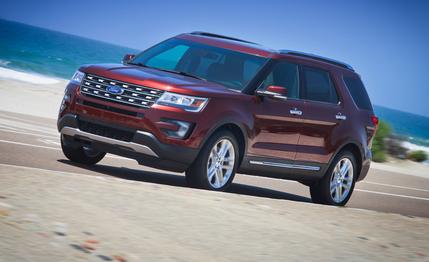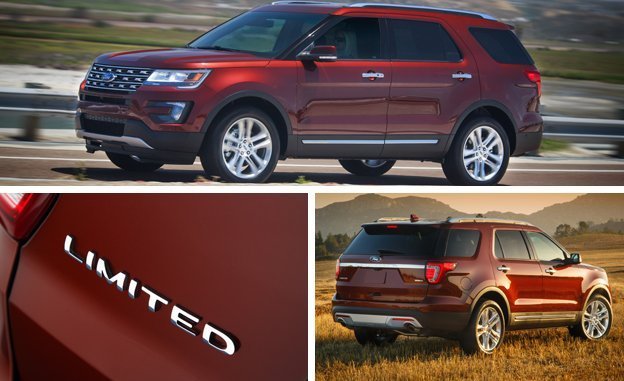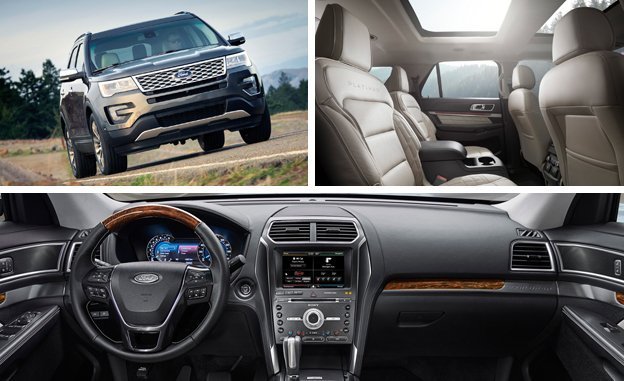
 First Drive Review
First Drive Review
Does it really matter whether the 2016 Explorer is any good? History suggests that it does not. The Explorer has been a juggernaut for Ford ever since the first one rolled off the assembly line and helped ignite the SUV boom at the dawn of the 1990s. Derived from the Ranger compact pickup, the original Explorer was a compromised vehicle, but it was wildly popular—and remained so despite a spate of deadly rollover crashes caused by faulty Firestone tires. Explorer sales finally began to trail off as buyer preference shifted to car-based crossovers. But when the Explorer followed suit, trading its body-on-frame architecture for unibody construction for the 2011 model year, sales rebounded. And despite increasing competition, sales have increased in each of the last five years. The model is currently America’s most popular three-row SUV.
For 2016, the Explorer gets its most significant update since 2011, but it’s not a complete redesign. The changes include new front and rear styling, a new top-spec trim level, and some new equipment. Mechanically, its most significant change is the arrival of a new EcoBoost four-cylinder engine.
The 2.3-liter EcoBoost replaces the previous 2.0-liter, which had been an extracost option over the standard 3.5-liter V-6 but has had a miserable take rate running between two and four percent. Why does Ford think it will be different this time? Several reasons: First, the 2.3-liter’s 280 horsepower and 310 lb-ft of torque represent increases of 40 horsepower and 40 lb-ft over the smaller EcoBoost four. Second, unlike the 2.0-liter, the 2.3-liter will be available with all-wheel drive as well as front-wheel drive. And finally, where the 2.0 was not recommended for towing, the 2.3 can tow up to 3000 pounds.
We drove the 2.3-liter with both front- and all-wheel drive and found this EcoBoost four to be up to the task of moving the hefty Explorer. Off-the-line acceleration—say, jumping out into traffic—is a little tepid, but once you’re up to 30 mph or so, the Explorer moves along pretty well, and highway passing is no problem. The EcoBoost doesn’t sound particularly great when you’re caning it, but it does not appreciably change the character of the otherwise quiet Explorer.


Whether buyers will want to spend $995 for the four-cylinder’s superior fuel-economy ratings over the naturally aspirated V-6 is another question. The V-6, with 290 horsepower and 255 lb-ft of torque, continues as the standard offering in base, XLT, and Limited models. At 19/28 mpg (FWD) and 18/26 mpg (AWD), the turbo four beats the V-6 by 2 mpg in the city and 4 on the highway in front-drive applications and by 2 mpg city and 3 mpg highway with four-wheel drive.
At the other end of the engine spectrum sits the twin-turbocharged, 365-hp EcoBoost V-6, and Ford is wisely making that engine more widely available for 2016. Paired exclusively with all-wheel drive, the turbo V-6 previously was exclusive to the Sport but is now found under the hood of the new Platinum edition, as well. Besides the EcoBoost V-6, the Platinum gets unique trappings inside and out that include a chrome-mesh grille and quilted leather upholstery. (Some might see these as another example of Ford design’s obsession with Bentley.) It also comes standard with everything you can get on an Explorer—a fact that’s reflected in its eye-opening price of $53,495. Ford, however, says that the vast majority of Sport buyers were opting to go all-in on that model, so they figure the market is there for a loaded-up Explorer with the top-spec powertrain but without the sporting pretension.
In fact, with the Platinum catering to the gimme-an-Explorer-with-everything crowd, Ford has been able to make the Sport a bit, well, sportier. The spring rates and dampers have been stiffened, and the steering retuned slightly. We can’t say the changes have been transformative, however. Our experience on the curvy roads in the hills east of San Diego showed the Sport to be pretty much as we remembered: a surprisingly good handler for such a big boy—although the same actually can be said of the standard-issue Explorer. Nor have the suspension tweaks appreciably diminished the Sport’s ride quality, which remains quite good even on 20-inch rolling stock. The turbo V-6’s 350 lb-ft of torque continue to make it one of the most potent engines available in a three-row crossover. Its overly aggressive throttle tip-in is hardly necessary to create the impression of strong performance; the last time we tested an Explorer Sport, we measured a zero-to-60 time of 5.9 seconds, and the new one should fare similarly. That’s plenty quick enough to get the kids to soccer practice on time.


The Platinum comes with everything but, commendably, buyers don’t need to step up to the Platinum to get many key features. Starting with the basics, all-wheel drive is available on every version. Leather, navigation, and blind-spot warning are available on the XLT and higher, and the same applies to a choice of a bench or buckets in the second row. Lane-keep assist and adaptive cruise control with forward-collision warning are optional on Limited and Sport. New features for 2016 include a hands-free power liftgate, washers for the 180-degree front and rear cameras, and additional functionality for the available automatic parking system.
While the interior of Platinum models is awash in fancy trim, with real wood, matte aluminum, and glossy plastic featuring prominently, lesser Explorers have seen a mild revision, too. Redesigned door panels have a more comfortable armrest, and the dash trim is nicer. But some of the Explorer’s packaging limitations remain. Despite a reworked driver’s dead pedal—which moves forward and changes its angle—the wheel-well intrusion is still pronounced, making for a somewhat awkward driving position. A high cowl and wide, flared A-pillars can make one feel buried in the car. Ford has carved out a bit more knee room in the second row thanks to slimmer front seats. The third row remains one of the best in its field, although it’s strictly for two, whereas some competitors (rather optimistically) have seatbelts for three. The cargo hold behind the split third row is also better than most, thanks to a well in the floor.
We prefer the slightly better packaging and sleeker profile of the Explorer’s sister model, the Ford Flex. The Flex doesn’t get treated to any of the updates visited upon the Explorer this year, but it does offer buyers a way to get the EcoBoost V-6 for slightly less: A Flex Limited with EcoBoost costs $43,795, versus $44,195 for an Explorer Sport, and the Flex comes with navigation and blind-spot warning that are optional on the Sport.
But in terms of sales, the Flex is no Explorer. With the exception of fashion-forward California—and Ford’s home base in Detroit—the Flex doesn’t sell. The Ford Explorer is the SUV everybody wants. The 2016 changes should help keep Ford’s SUV juggernaut rolling, maintaining its position as one of the popular, and profitable, pillars of the company’s lineup.